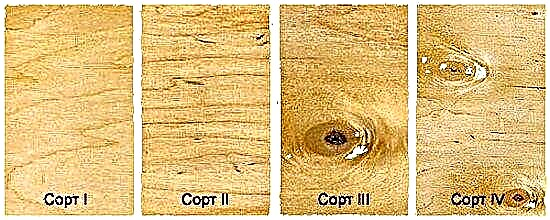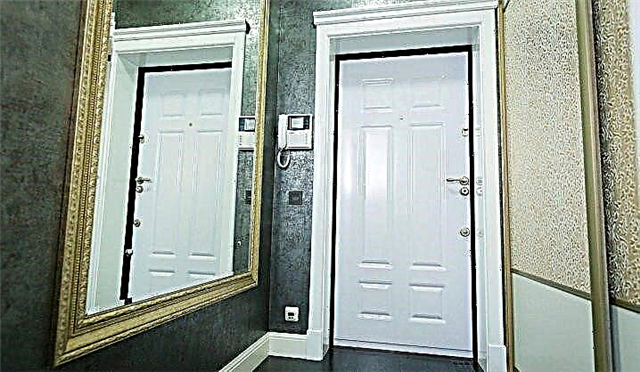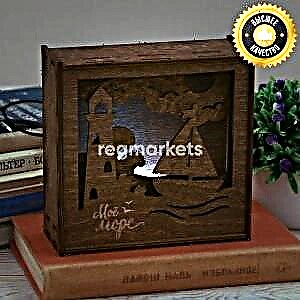Sort out, what is a tapestry and how to choose durable products from it, employees help us Tapestry shop. There are a lot of original pillows on the site of this store with realistic images of animals, beautiful patterns and drawings. For interior decor there are bedspreads, paintings, panels, napkins, tablecloths and even fashionable bags.
Tell me, what is this fabric, how is it produced?
The first tapestries appeared in France in the 17th century, the name of the fabric was named after the Tapestries brothers, who own a weaving factory for the production of this amazing canvas. Later, the company bought Louis 14, and tapestry carpets became the hallmark of France.
Speaking in a professional language, a tapestry is obtained by weaving a weft and a warp (longitudinal and transverse threads). Technically, the process is simple, but the complexity and value of the paintings - luxurious ornaments and plots that create on the machine, and not by printing on fabric. The result is a very beautiful and realistic image, similar to a painting.
Previously, tapestries were very expensive, as weavers worked by hand, spending a lot of time on manufacturing. For a year, a master can only weave manually one and a half square meters canvases! Modern machines work quickly, and the quality of the material has even improved. Look at which cat pillows we sell, they do not leave anyone indifferent!

And how to choose a tapestry for the interior, so as not to fall for the trick of an dishonest manufacturer?
A tapestry from a well-known manufacturer is always of good quality, since it is difficult to “trick” it into production. Pay attention to image quality, product thickness, inspect the purchase from the front and back sides. See the composition of the canvas. Natural fabrics are made from wool, silk, linen. However, they are not afraid of synthetics, it simplifies maintenance and makes products more practical.
If you live in Moscow, come to our store by the address: Michurensky Prospekt, Olympic Village, house 4.corp 3. We show, tell, help you choose.
When choosing products, consider the color and stylistic combination with the existing interior and decor items. When buying a panel, think about where it will hang. Tapestry paintings look beautiful if they are located on a free wall and are adjacent to other wall decorations.
And how to care for a tapestry so that it serves for a long time?
It is best to dry clean the products. Small things can be washed at home in the most careful modes. Each product should have a reminder for leaving the manufacturer, and it must be followed in the care.
What tapestry products are suitable for the interior?
Curtains, pillowcases for pillows, bedspreads and sofas are sewn from tapestry. To decorate the interior create paintings, panels, napkins, tablecloths. A separate direction is the icons that not only decorate the home, but also create an atmosphere of peace and prosperity in it.
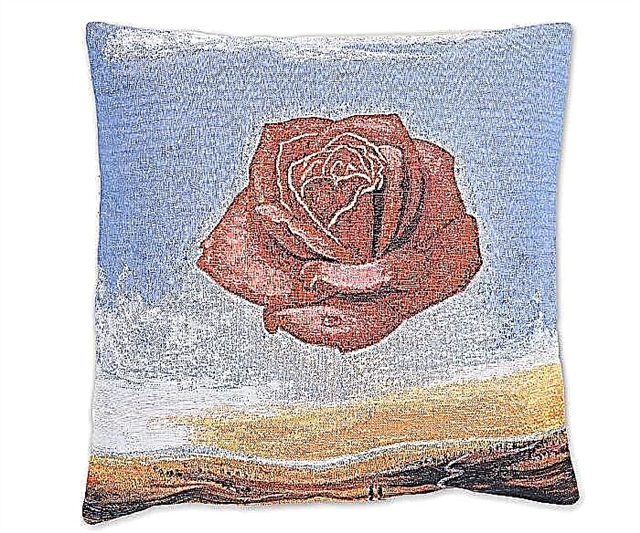
Tapestry curtains - maximum privacy and comfort
Luxurious tapestry curtains in the interior of a bedroom or living room do not have equal quality protection from prying eyes. Thick fabric leaves no chance for curious neighbors, even when the lights are on. Through such curtains, even silhouettes are not visible, so you can feel at home confidently and protected.
Tapestry curtains do not let sunlight into the room. Due to this, the room is not so hot in the summer, and furniture and wallpapers do not fade and do not deteriorate from exposure to ultraviolet radiation. The tapestry itself retains its original form for a long time, unless, of course, the manufacturer did not save on quality.
Dense material is suitable for creating simple curtains in one layer and for window decoration with tiered and draped curtains. Cloths go well with any tulle - from simple to luxurious. The main thing is not to forget about the severity of the material and ensure reliable fastening.
Tapestry pillows are the best choice for practical
Tapestry pillows are very practical, as the fabric is resistant to wear, is not electrified and is pleasant to the touch. Such pillows will decorate the living room, bedroom or children's room, if you choose a suitable pattern or funny pattern.
It is convenient if removable pillowcases, the tapestry can be vacuumed and cleaned, and the old pillow can be easily replaced with a new one or washed separately. Tapestry pillowcases serve for many years. They can be used not only in the apartment, but also in the country, in the gazebo, on the loggia.
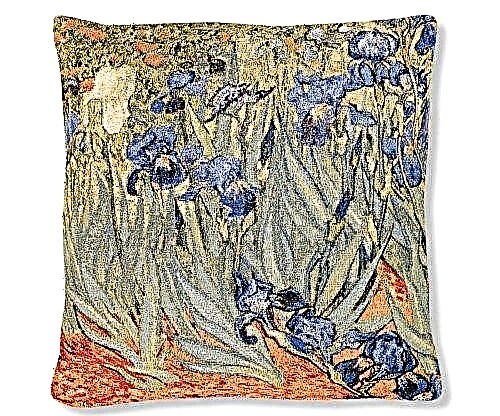
Bedspreads and covers for furniture
A good tapestry bedspread on a bed or sofa will decorate the interior and protect the furniture from dirt and spoilage. A bedspread is easier to dry clean than a sofa. Tapestry bedspreads are not covered with spools and resistant to puffs, they are very practical and durable.
On the bed you can lay a bedspread with a large pattern, for example, a huge sleeping beast or a flower glade. On a sofa that is used for its intended purpose, it is better to buy a tapestry bedspread with a small pattern. In such a picture, traces of time from heavy use will not be visible.
For children there are separate lines with funny children's drawings - the plots of favorite fairy tales, cartoon characters, heroes from famous games. Such things transform the interior of a children's room.
Pictures and panels - an alternative to carpets
Previously, tapestries woven carpets that adorned and insulated walls. Today, nobody hangs large carpets on the walls; they were replaced by paintings and panels. This decor looks very interesting. Modern looms can create realistic images that look no worse than paintings by famous artists.

Anything can be depicted on the tapestry, so such a decor can be easily found for any interior style - from luxurious classics to noisy avant-garde and meager minimalism. Style dictate plot and frame. Large paintings are an excellent choice for a spacious living room, while small ones look good above dressers, fireplaces, sofas.
Tapestry panels are ideal for children's rooms, bedrooms, living rooms, hallways. The panel can be supplemented with hooks or pockets, turning into a place to store small things. This option is ideal for the hallway.

Country is the best choice
If you like country, then boldly choose tapestries to decorate your bedroom and living room. For such an interior, products with traditional patterns and ornaments that are slightly rude, emphasizing the simple-haired rustic style, are more suitable.
In country, floor mats, tablecloths, napkins, curtains are appropriate. Complement the sofa with bright pillows or a bedspread. Instead of a wall carpet, hang a picture or a panel. If you wish, place a corner with an icon. Do not forget about the little things - hang a tapestry bag in the hallway on a simple hook or nail.
In a rustic style bright colors are appropriate, colorful drawings are acceptable. However, one should not forget about the sense of proportion and color combinations; busting will spoil all efforts.
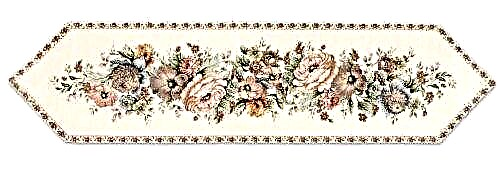
Classic tapestry sheet music
In a classic style, everything must be sustained in calm colors, cheap trinkets and bad taste are not allowed here. Choose solid decorative tapestry pillows for the sofa, good pastel or brown curtains, combined with natural wood furniture and parquet.
Tapestry paintings complement the interior and make it more status. In the large living room you can hang two paintings, maintaining the symmetry inherent in the classical style. One painting above the mantelpiece or over the sofa will look beautiful. Do not forget that the frames should be expensive, made of precious wood, and if metal, then with gilding or in silver.
In the bedroom in the classic style, lay a tapestry bedspread on the bed, select pillowcases for pillows, and close the windows with heavy curtains. Find a place for a picture or a panel above the bed. By closing the walls, you will provide not only comfort, but also additional thermal insulation, if the wall is external, it is for this purpose that carpets were previously hung on the walls.

Modern in tapestry
Modern is the style of those who like classic with a twist and modern notes. Tapestry in the interior of the living room or bedroom in modern style is more than appropriate. Do not forget to adhere to the main directions of modernity - choose to design tapestry with floral and floral ornaments natural shades of nature. They ate a small room; paintings with landscapes and boundless seas would help out.
The curtains in the living room or bedroom should be up to the floor, tiers and expensive pickups are welcome. For the color of the curtains, choose a tapestry bedspread on the sofa and chair covers. Do not forget about the little things - tapestry boxes, album covers, lampshades, all this will make the atmosphere warmer and more homely.
Tapestries in contemporary design areas
A modern tapestry does not violate the style of newfangled design directions. Bright avant-garde drawings, fashionable black and white combinations in the style of photography, pillows with images of cartoon characters, panels and paintings with realistic volumetric plots - all this is acceptable in a modern interior.

The main thing is to maintain the style and do not mix styles, unless, of course, this is eclecticism, the main advantage of which is the ability to mix and match similar design trends.
Instead of classic sofa cushions, choose comfortable cushions. Prefer fashionable modular paintings or panels with futuristic scenes.
The tapestry goes well with concrete and masonry, which means it fits organically into the loft and industrial style.

How to quickly update the interior
When it is not possible to buy new furniture or make repairs, the tapestry will help out - with its help it will not be difficult to update the interior, changing it beyond recognition.

- A new tapestry bedspread on the sofa will not leave a trace of the old furniture that is bored, it will hide the abrasions of the upholstery, stains from baby food and puffs left by the cat.
- Tapestry pillowcases are a great alternative to buying new pillows. By the way, in such pillowcases it’s very convenient store spare bedding, blankets, winter clothes. No one will guess that these are not pillows, but full-fledged storage places. Beauty and significant savings in cabinet space.
- Many tapestry pillows of different sizes will transform the simplest and most boring sofa. If the old cushions have lost their shape, throw them away, replace them with new ones and enjoy the updated new thing and comfort.
- Tapestry paintings will add luxury to even the simplest wallpapers. A correctly selected image will correct the shape of the room - make it wider, larger and even higher.
- Woven napkins will decorate old furniture, hide scratches on a chest of drawers or a bedside table.
- A new tablecloth instantly transforms the old table, preparing to leave the apartment.
Try using a tapestry in the interior of your living room or bedroom and make sure of its modernity, beauty and practicality from your own experience! The products shown in the photo can be bought at the gobelin shop.rf.
If you like to create coziness with your own hands, take a look at our House section, there are tips for those who want to live in a beautiful environment without extra expenses.
Tapestries in various styles
Despite the fact that after the collapse of the USSR, “a carpet on a wall or on a bed is a relic of the past, this is a village” was heard everywhere, many people are in no hurry to abandon this not only beautiful, but also warm-keeping interior detail. And they do the right thing, not every carpet is atavism, which cannot fit into the general style, many of them are so original that they look harmoniously in the most popular directions today. Tapestry fabric provides such a wide field for imagination that few people will turn their tongue to call artfully hand-woven work or embroidery with an ordinary old carpet.

The attitude to such an element of decor is ambiguous even in the professional environment of designers and decorators

Decorative canvas with fish complements the interior of a modern living room

Bright, spectacular canvas in a stylish living room

Bright Mexican motifs look spectacular against white walls.

The tapestry on the wall completes the warm, cozy interior of a wooden house
Tapestry and popular destinations
- East. The visiting card of any oriental interior is considered to be a soft woven carpet, it is used everywhere - on the floor, on the walls, as a bedspread, even as the texture of cushioned pillows. If there are oriental notes in your house - an abundance of thought, hookahs, jugs or vases with sharp necks, canopies, a large amount of textile, etc., the tapestry will fit perfectly into the big picture. In addition, bright oriental patterns are now in trend, after all, if someone is fundamentally against the carpets, it can be a thematic embroidery on sofas.
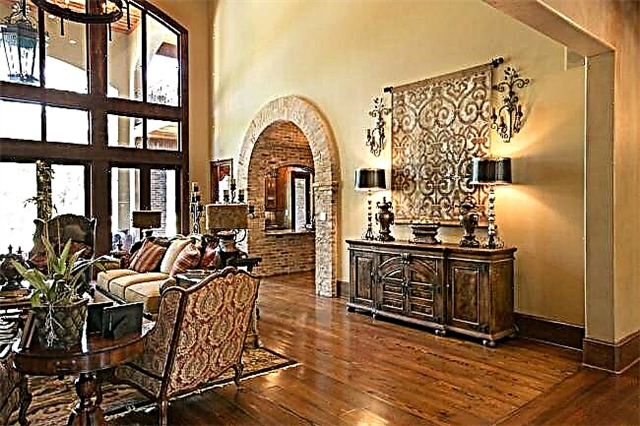
Oriental tapestry ornament fits organically into the solid interior of the house.

The wall-mounted carpet perfectly complements the interior of the patio, made in oriental style.
- Scandinavians. Photos of Scandinavian interiors are replete with dense wall fabrics with beautiful embroidery, designers intended them the role of accent spots. A large picture of a tapestry, which, if desired, can be made by yourself from any special set, can serve as such a bright detail, the technique of its manufacture is quite simple, but it will take some time due to the large volume.
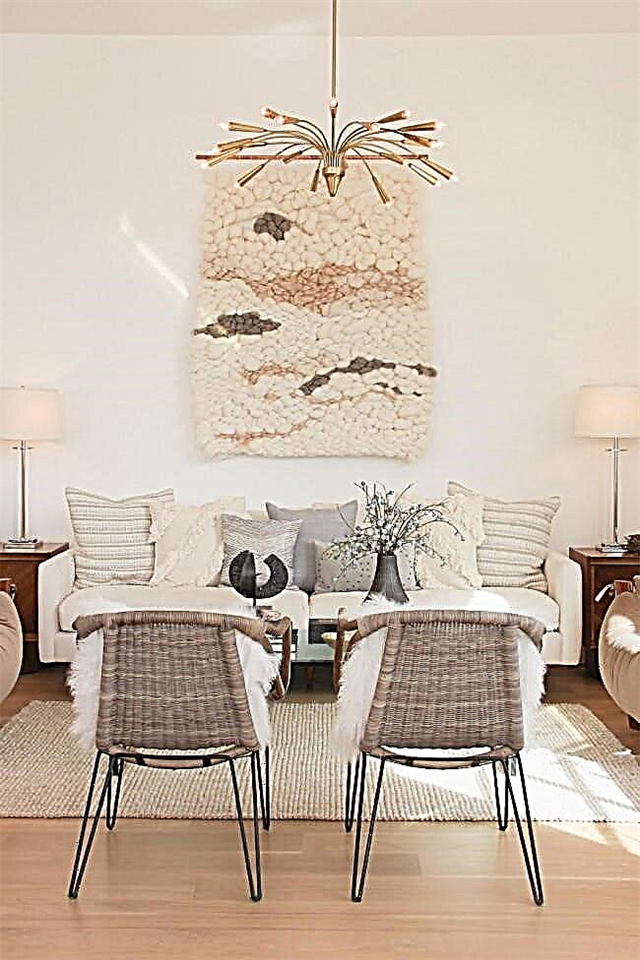
The main raw materials are usually wool, sometimes cotton or linen.

Tapestry with a characteristic ornament in the living room, made in a restrained Scandinavian style
- Modernity. Tapestry and modernity have been compromised in vibrant abstract designs. They are not often hung on the walls, but tapestry covers for sofas, an armchair with colored original embroidery or a woven carpet on the floor often serve as a highlight and decoration of rooms. Many stores today offer bedding sets for the bedroom, which include decorative tapestry pillowcases and a bedspread, you can buy them in the bedding department.

Even in the loft style there is a place for tapestry

Canvas with a geometric pattern in an eclectic bedroom
- Classic. The use of tapestry in the classic interior resonates with the design of castle bedrooms, where the main place for carpets with drawings or huge paintings was allocated to the head of the large bed. Many owners of modern apartments, inspired by the palace decorations and loved luxury, even pull the fabric with the image of a famous plot instead of wallpaper on a full wall in the bedroom.
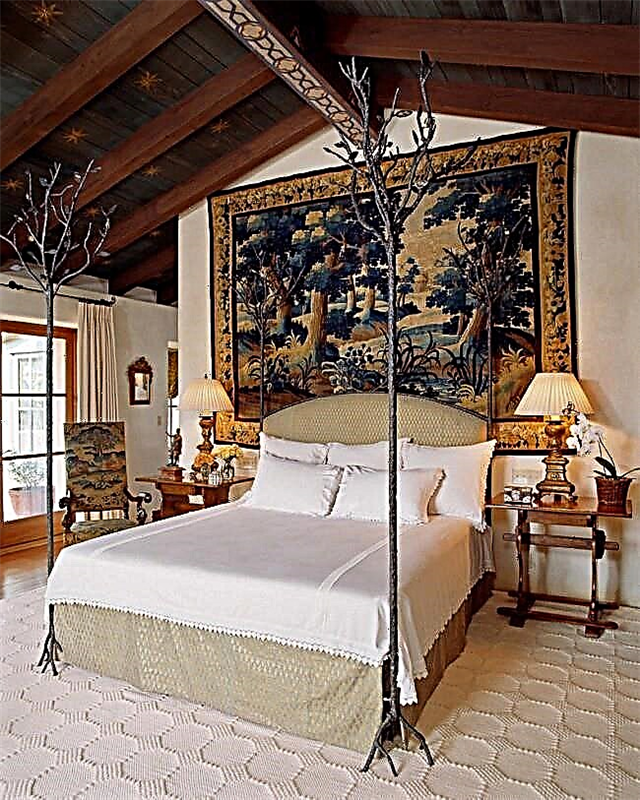
The unsurpassed luxury of the classics is emphasized by the wall tapestry
- Vintage. In this style, the “chip” of the year, designers have identified a combination of tapestry in the head of the bed and the same carpet in the room on the floor. At the same time, the walls should be in pastel colors and monophonic, in order to emphasize the woven nuances and not give a feeling of excessive variegation, the floor should contrast with the dark.

Canvas with a "faded" effect creates a sense of antiquity
By introducing tapestries into fashion, the designers immediately gave some useful tips that would prevent your carpets and bedspreads from being associated with ghosts from the past.
Secrets from designers
- You cannot use more than one wall-mounted carpet in one room,
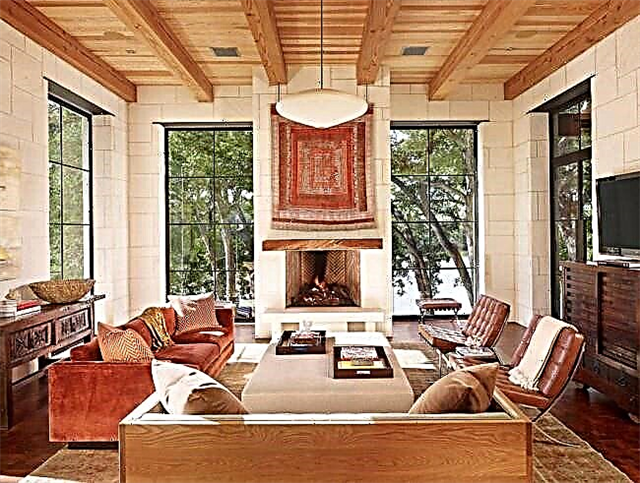
This is an absolutely universal decoration tool.
- each tapestry should be combined with other textiles,
- tapestry paintings look better when they are large enough,
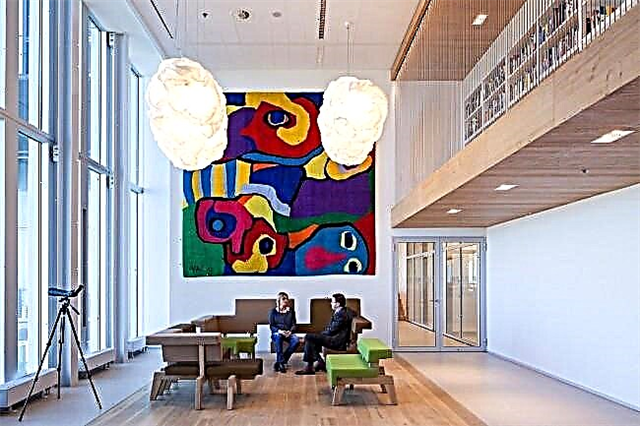
Huge tapestry - a bright, spectacular decoration of a minimalist living room
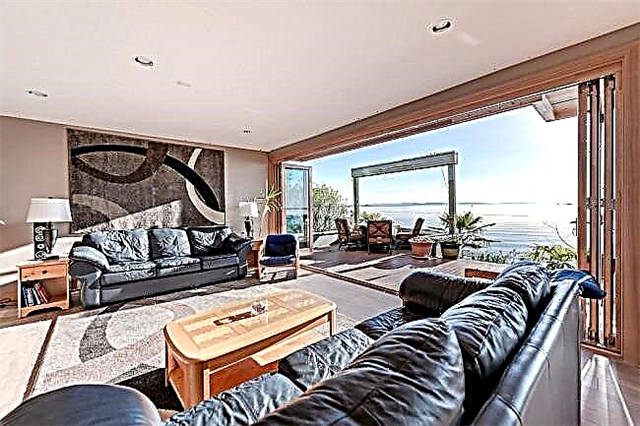
Wall woven fabric gives the room even more comfort and warmth
- if you use fabric, such as a bedspread or sofa set, do not immediately hang it on the wall or put a carpet on the floor, the picture will be more appropriate, but it is better to do without it at all.

The decor with trellises with an abstract pattern can be an interesting accent in a bright outdoor room in a modern or eclectic style.
If you decide on the classic use of a woven carpet and are going to put it in the head of the bed, or pull it on the entire wall, you should think about the image well.

Decorate the wall behind the sofa with a large tapestry
From the Middle Ages to the present
The history of tapestries is rooted in the distant past: even in ancient Egypt this weaving art was known. But the prototypes of modern tapestries are the works of medieval German monks. The woven carpets that hung the cold walls of the monasteries were by no means used for decoration, but served a completely utilitarian task, providing thermal insulation of the rooms.
By the end of the Middle Ages, this art began to flourish in Western Europe, workshops began to appear that produced tapestries for wealthy citizens. Making carpets at that time was a very expensive and painstaking affair: a tapestry could take several years of the work of an entire village. The acquisition of such products could only afford members of the royal families and representatives of the highest nobility.
The most frequent images of that time were biblical motifs, as well as plot paintings depicting hunting, life at court, military campaigns. When fresco paintings spread in southern Europe, tapestries began to replace them in cooler countries, borrowing both plots and color tricks from frescoes.



Paris became the center of tapestry production in the Middle Ages, where these paintings were very popular. Those who could afford ordered a series of paintings. They were used to decorate houses and temples, with their help they created mobile corridors in the streets for holiday processions, they decorated the stands at knightly tournaments. Sketches for tapestries were created by Raphael, Rubens and other eminent artists of the past. Today, most of the ancient tapestries are displayed at expositions in major museums in Europe.
In parallel, the development of weaving craft proceeded in the east. In the territory of Mongolia, Ukraine, Moldova and Russia, lint-free carpets were also woven, which were used both in home decoration and in ritual ceremonies. They were very different from European tapestries: they were mainly decorated with floral and geometric ornaments, but the manufacturing technology was very similar.
Tapestry fashion came to Russia in the era of Peter I. From its submission to St. Petersburg, weaving masters were invited and the first tapestry workshop was opened. The first Russian tapestries depicted scenes of paintings by French and domestic artists.
With the development of factory production, the artistic level of tapestries fell sharply. They ceased to be luxury, became more accessible to the ordinary population, and images were increasingly copied from popular art paintings.

The second wave of popularity of tapestries in the world occurred in the twentieth century. Picasso, Matisse, Dali, Kandinsky - these are just a few artists whose sketches were taken as the basis for new products. It was then that the tapestries from applied craftsmanship turned into a component of high art, which remains to this day.

Tapestries in modern interiors
Oriental interior is unthinkable without carpets. They are used not only to cover the floor, but also as a decoration of walls, bedspreads and wraps on furniture. Tapestries fit perfectly into the overall picture of oriental decoration. Several bright decorative pillows made using this technique, or the upholstery of the chairs will be the perfect color accent.

Tapestries are also appropriate in Scandinavian interiors, where they are given a place as sofa cushions, heavy bedspreads or wall panels. For this style, tapestries with simple floral and geometric ornaments should be selected.
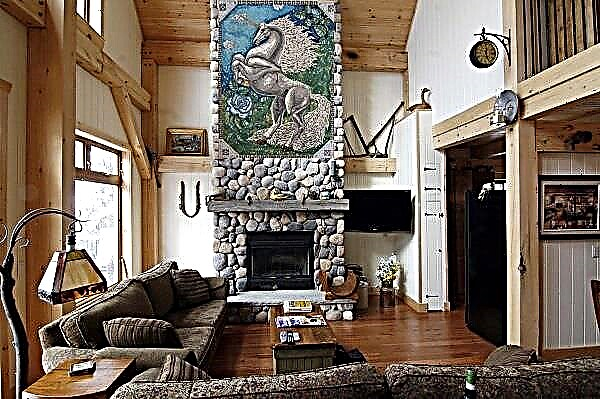
The most logical use of tapestries is in palace interiors. Classic scenes framed by rich frames made of natural wood will be a worthy conclusion to the luxurious decor.

Abstract woven panels complement the decor of any modern interior, whether contemporary or hi-tech.
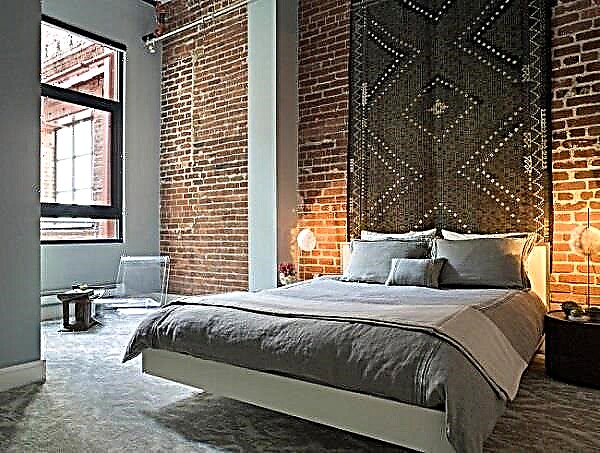
Popular tapestry images and their relevance in design
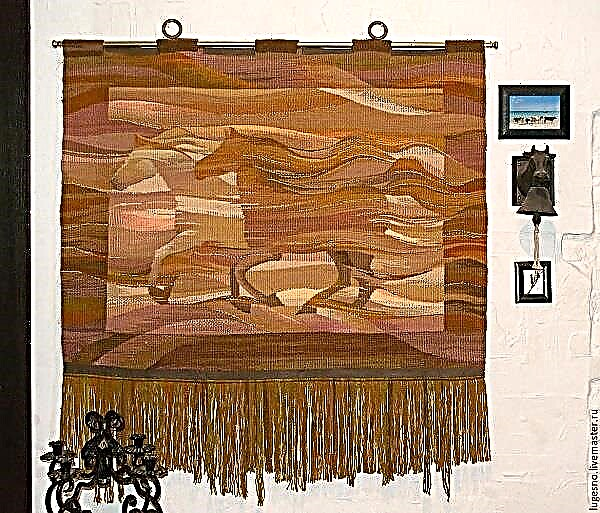
- Architectural buildings, heraldic motifs. Look good in classic interiors, but will not overload them only with sufficiently high ceilings.
- Mythical creatures. Psychologists say that such images affect the subconscious, so they do not have a place in the bedroom.
- Reproductions of famous artists. It is quite appropriate in most modern interiors, it will look best in the living room.
- Landscapes. A good location is in the bedroom, as they pacify and relax.
- Still lifes and floral motifs. Lungs, do not cause overexcitation and unpleasant emotions, due to which they are suitable for any room.
- Abstractions make any interior original and spectacular.

The revival of interest in the tapestry is not surprising. The texture, color saturation, value of manual labor turn the tapestry into one of the most striking emotional accents of the interior.
What it is?
To begin with, it is worth answering the question of what a tapestry is and when it appeared. Tapestries are called woven paintings that depict various landscapes, historical scenes, or other luxurious images.
It is known that the first tapestries appeared in ancient Egypt. Then they were used to capture some important historical moments. Later, similar equipment began to be used in France and Switzerland. French tapestries were considered the most luxurious. They were considered not just a wall decoration, but a real work of art that deserves special attention.
Over time, such tapestries spread throughout the world and became a real decoration of luxurious castles and royal residences.


To date, tapestries have again become popular. They are great for decorating houses and apartments in different styles. A luxurious massive tapestry will help to convey the spirit of another country and create a mysterious atmosphere in the room.
In addition, tapestries, especially large ones, are capable of damping sounds, which is also relevant in apartments with thin walls and poor sound insulation. Such characteristics make it very practical in everyday life. The technique of creating tapestries is still quite complicated, which justifies the high price of products. In addition, carpets, handbags and even outfits are being sewn from tapestry.
Varieties
Now tapestries are called not only antique works of art, but also stylized carpets. Let's look at the main differences between classic tapestries and models created in a similar technique.

Smooth
Wall carpets are a trend that has long been a thing of the past. But stylish tapestries, on the contrary, are gaining popularity. The simplest option is smooth models without a relief pattern and additional volumetric decor. Such tapestry rugs are created using traditional techniques. They can be easily hung on the wall or laid on the floor, depending on your aesthetic preferences.


Textured
A slightly more complicated version of tapestries is textured products. In this case, the product is created using traditional techniques, and only then is decorated with convex stitches. This allows you to create a relief canvas, which is attractive not only because of its appearance, but also to the touch.
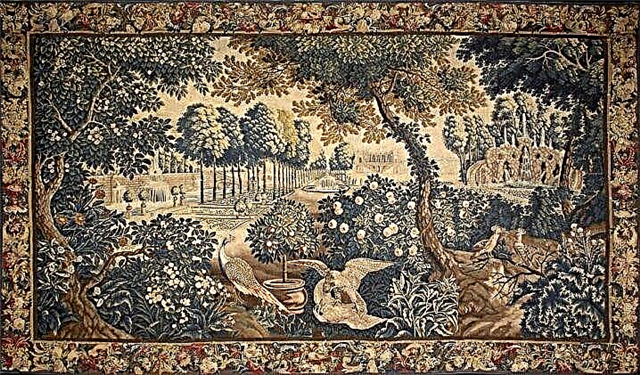
Layered
Such a combined model is also very interesting in appearance. Here several techniques are combined at once. For example, a crocheted rug can be complemented by elegant embroidery or fringe around the edges.


Non woven
This is one of the most interesting options for creating tapestries. Such paintings are made of fabric, but by other techniques. Most often, such tapestries are created using embroidery, knitting or applique.
Now there are many interesting options for tapestries, both large and small. Therefore, you can safely choose a beautiful decorative attribute, regardless of whether you need a vintage and truly antique product or just a stylish decorative element without any history that it would have kept.
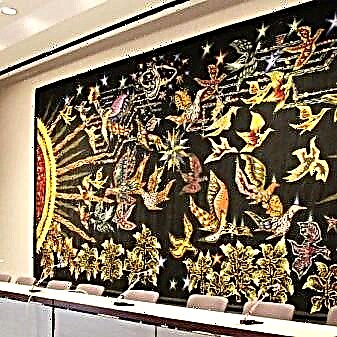

Selection tips
Choosing a beautiful and truly high-quality tapestry can be really difficult if you are faced with such a task for the first time.
It should be borne in mind that tapestry cloths, unlike obsolete massive carpets, can be hung in almost any room. The tapestry can decorate a bedroom, a drawing room, an office, a nursery and even a kitchen. The only exception is the bathroom and the cold balcony room, where it is simply impossible to create suitable conditions for it.
One of the most important rules for choosing a tapestry is that it is not too bright and matches the color of the rest of the interior.
In general, a tapestry is a beautiful art object that should only combine different parts of the room. To avoid busting with the decor, the tapestry should be the only decorative element in the room, especially if it is small. Near the canvas is not advised to hang on the wall any additional paintings.
The plot of the image you need to choose based on the style in which your room is decorated. In a room for children, it’s logical to hang some cute pictures, possibly scenes from famous fairy tales, captured on the canvas.
Also highly valued are products that depict various landscapes, historical scenes or reproductions of famous paintings. Such beautiful tapestries may well be a great holiday gift for the connoisseur of such works of art. Many will also like the small size tapestry with the image of heraldic symbols or paraphernalia associated with a particular country.


By the way, it would be interesting to look at a combination of a tapestry canvas with other similar elements, for example, with a bedspread or pillows made of the same fabric or decorated with similar patterns.
When choosing a suitable canvas, attention should be paid to dimensions. As already mentioned, the smaller the room itself, the more compact the picture should be.
Otherwise, you will get a very unpleasant effect - the tapestry will “eat” all the free space and make it visually smaller. In a large room, a small tapestry, on the contrary, gets lost on the background of empty walls.

Materials
Although it seems to many buyers that all the tapestries are similar to each other and are made from the same material, in reality this is not so. Tapestries are most often made from fabrics with high density, and this is the main thing that unites them. Most often, when creating tapestry paintings, modern manufacturers prefer fabrics such as jacquard.
This material has a dense texture, in addition, it is easy to apply the desired images to it.
Less commonly, you can find a thin cotton or dense woolen or terry tapestry. But such products have certain advantages. For example, warm wool has properties such as heat and sound insulation, and cotton is suitable for bright rooms.


Design
Not only the material from which the tapestry is made is distinguished, but also the patterns that adorn it. Let's look at the most popular and common motives.
Ancient paintings
There is no better find for a collector and lover of antiques than a stylish tapestry that adorns a reproduction of an old painting, especially if it is a handmade work. The most popular topics are the image of hunting (royal hunting is especially common), balls and receptions, where ladies are portrayed in luxurious dresses and surrounded by beautiful things.
Such a picture will fit perfectly into the library or home office, stylized antique. The same applies to large maps of the world with a huge number of small details and images of various castles and other ancient buildings. For example, a white castle towering on a hill by the sea is one of the paintings that will surely delight a connoisseur of art.


Landscapes
Another popular genre is landscapes. Here you can find almost anything - from a scattering of roses all over the canvas to the image of a small village in the style of Provence. A garden of paradise or a picture of a spreading tree against the backdrop of sunsets is an excellent option for decorating a bedroom or living room in any style. All kinds of peonies, roses, sunflowers and other flowers will definitely appeal to girls and romantic natures who appreciate the beautiful.
Special attention should be paid to animal images. Cute cats or puppies always cause tenderness for both adults and babies. A picture with red deer is quite suitable in order to decorate with it even a private office.

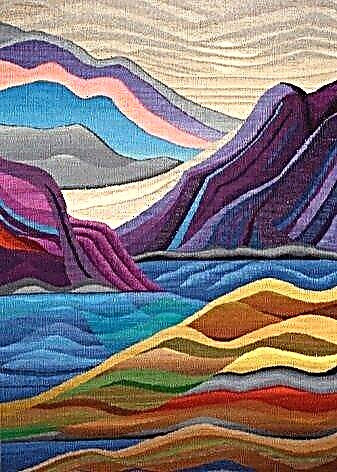
Household topics
The tapestry “house” implies an image of simple and familiar paintings: it can be a family scene, a lunch or a bouquet of poppies standing on a table, fishing or a family dinner. Such a decorative element will add comfort to the room and will certainly delight you for a long time.

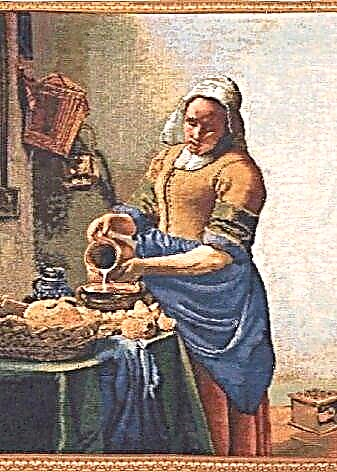
Abstract
A completely different genre is incomprehensible and non-standard paintings, which are called abstract art. Unlike classics, abstract art is not always clear pictures. A tapestry in this style may well be a simple combination of bright colors. Red, blue and green shades are intertwined so that it is difficult to understand exactly what the author wanted to say. But at the same time, this is what fascinates.
By the way, among such canvases, you can find reproductions of paintings by famous impressionists and abstractionists who will definitely revitalize your interior and emphasize the good taste of the apartment's occupant.
These are the main types of finishes, although, of course, you can find other options for images. For example, practical tapestries with a calendar or an image of a family tree are especially popular now. And for the nursery, you can pick up a picture with characters from anime or pages of your favorite book.
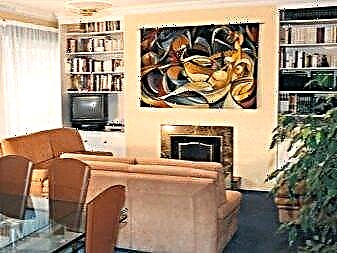
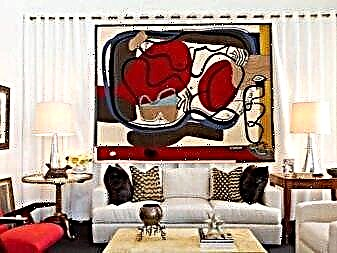
The main types of weaving
Most often, tapestries are created using a loom. The essence of manual weaving is that the threads are intertwined. There are several different techniques, and depending on which one you choose, you can get different results. By the way, machines for creating tapestries can be created with your own hands, if you have experience working with wood.
Before proceeding to weaving a tapestry, you need to select a suitable pattern and transfer it to a workpiece consisting of threads stretched onto a machine. When such a peculiar sketch is ready, you can proceed to its embodiment in color.
Inclined lines
As a rule, several types of different weaves are combined in one tapestry at once. This allows you to obtain the desired image and combine flat details with embossed ones. Inclined lines are those places where the threads of two colors are connected in one place.
This type of weaving is used where you need to give the image a roundness or make its shape curved.
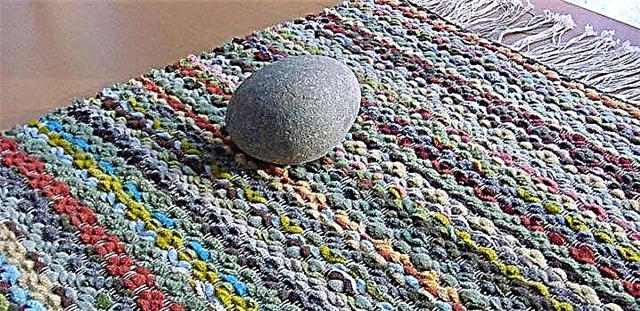
Circular technique
Circular technique, according to the masters, is not so common. However, it is also interesting in terms of what the result is in the end. Threads of different colors in this case go in a circle, and the finished image seems to be a work of art, drawn with wide and confident brush strokes. It looks really impressive and beautiful.

Contour technique
As the name implies, this technique is used to emphasize the contour of an object. For this, as a rule, more dense threads are used than in the warp. If you use this technique, then the picture is more clear and elaborate.
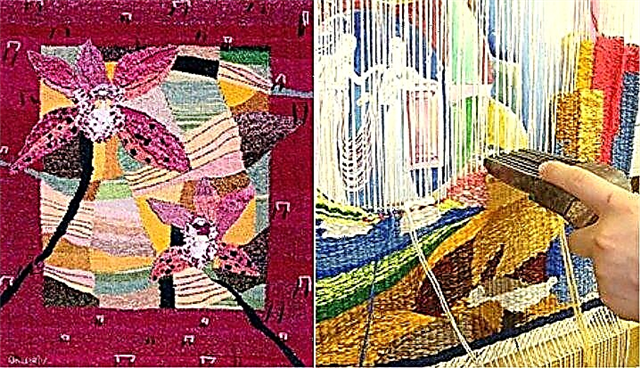
Decorative harnesses
Decorative flagella - this is what can give the finished work an additional appeal. With the help of bundles, the warp of the thread is wound in certain places. Most often, this technique is used to frame individual fragments or to focus on parts of the tapestry.


Additional decor
In addition to the basics of weaving, you also need to remember about additional decorative elements. Feathers, beads and other details are used to decorate the tapestry. Sometimes even grass stems and dried flowers are woven into the finished pattern. This makes the picture more complete and embossed.


Manufacturers and reviews
When the tapestries first appeared, the most popular products were those created by French craftsmen. Now everything has changed a little and quality products from tapestry fabric are produced all over the world. French, Italian and Belgian products are very popular.

Of domestic products, Ivanovo factories are especially popular. They look beautiful, and quite unpretentious in operation. Traditional Russian motifs, which cannot be found among tapestries from foreign manufacturers, are also pleasantly pleasing.
It is domestic tapestries that have earned a reputation for quality and inexpensive. They are easy to clean, look good for many years and at the same time you do not have to spend a huge amount on the purchase of this decorative element in your home or apartment. So, even a person with an average salary can afford such a luxury.

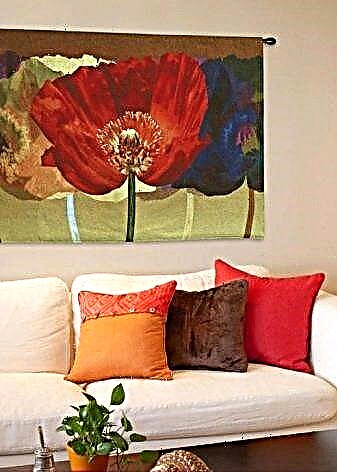
Place in the interior
In the end, it is worth mentioning how to use tapestries to decorate any of the rooms. After all, the overall impression will depend on how appropriate it will be in the interior and how well the picture will fit into it. Even the most expensive canvas will seem superfluous and inappropriate if it is incorrectly selected. So, your money will be wasted.
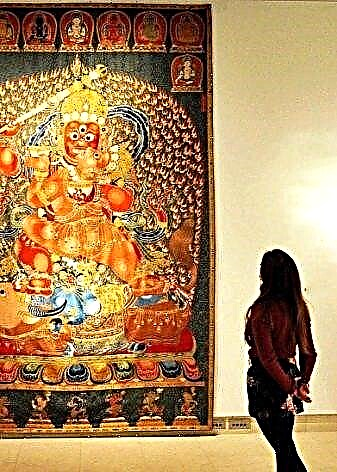

Use instead of wallpaper
Beautiful and large tapestries can easily be used instead of wallpaper in case you have a small room. Most often, one of the walls is decorated in this way. This is more profitable and much more interesting than simply sticking wallpaper around the entire perimeter of the room. Dense tapestry cloths are a great way to insulate a room and create excellent sound insulation.

In the bedroom
A beautiful tapestry can be safely hung in any of the bedrooms. It can be a children's room or a room where adults rest. Here, by definition, it all depends on what picture is applied to the fabric. For example, in a nursery it’s most logical to use cute cartoon or fairy-tale images, and in the bedroom of a married couple - landscapes or romantic pictures.

In the office or library
Another room with tapestries that deserves attention is the home office or the library. A beautiful old vintage tapestry is a luxurious addition to any cabinet. Restrained pastel colors, ancient patterns and other beautiful details will be appropriate here.


In a country house
The use of tapestries in country houses or in the country deserves special attention. It is in such conditions that they look most organically. Here, ancient or stylized antique paintings with images of nobles, royal hunting or architectural works of art will be appropriate. With a beautiful and correctly selected tapestry, even the simplest cottage will become much better and more comfortable. And of course, do not forget about how well tapestries insulate walls. So, with a luxurious canvas, it will be much easier for you to survive the cold winter.
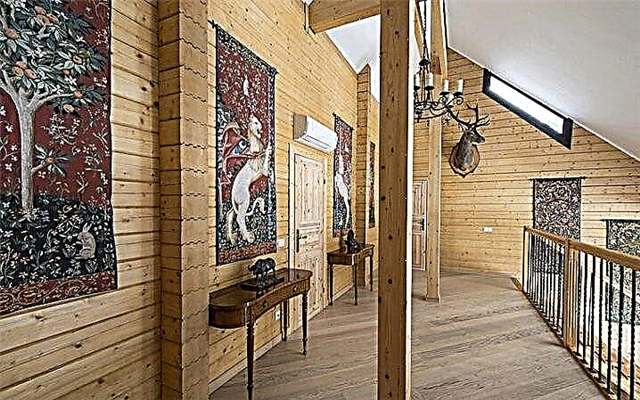
Choose a tapestry canvas that matches all interior features in color and style. The product should go well with the color of other fabric products, for example, with curtains, blankets, rugs, pillows or other textiles. So you can create a harmonious and thoughtful interior that will look much more original than any simple room in a standard design solution.
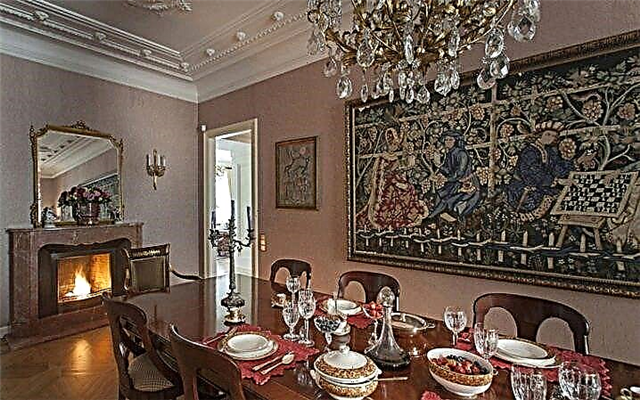
If earlier tapestries were used to decorate the homes of nobles or other luxurious rooms, now almost anyone can safely decorate their premises with such a product. Choose a modern tapestry that suits your style and mood or buy a luxurious antique product, and your interior will come to life and sparkle with new colors.
You will learn more about how to decorate the interior with a tapestry from the next video.
History of occurrence
The origins of trellis creation are very difficult to trace. This is due to the fact that many nations independently engaged in and developed weaving within their ethnic group. The oldest tapestries come from Egypt. In the tomb of Thutmose IV (XV BC), linen was found depicting scarabs and lotuses, and in the tomb of Tutankhamun (XIV BC) - a dress and gloves, made in the likeness of a trellis. But such good reasons to claim that these are the very first tapestries are not proof of this.
Historians claim that the Egyptians adopted this type of weaving from the peoples of Mesopotamia, as evidenced by the records of ancient authors.
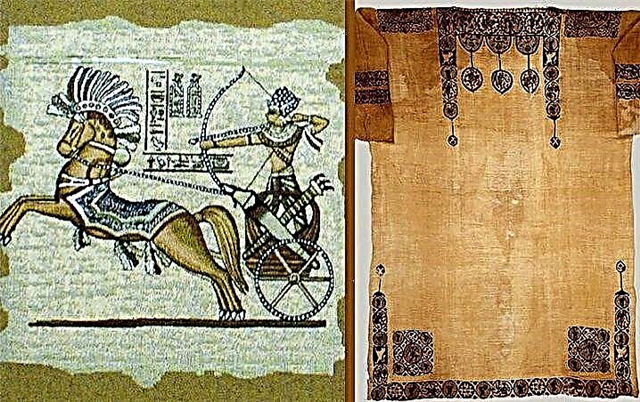
In Homer's poem Odyssey, there is a mention of burial objects made using the tapestry technique. This fact indicates the existence of weaving in ancient Greece and Rome.
At the other end of the world, in pre-Columbian America, mainly in ancient Peru, elements of trellis were found during excavations, most of all by the application of relevant modern ideas about tapestries. Peruvians not only decorated walls with woven paintings, but also used them, hiding from drafts.
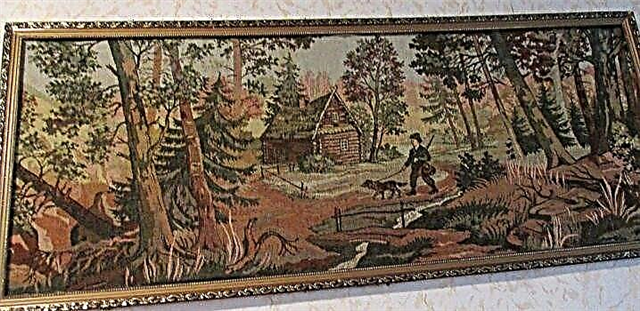
Sophistication and special subtlety were distinguished by ancient trellis from China. Chinese craftsmen used motifs taken from nature to create such decorative elements and clothes: unusually beautiful and exotic flowers, twisted stems, sophisticated landscapes. The art of this type of weaving from the Chinese peoples was adopted by Japan.
Tapestries gained wide popularity in Europe in the Middle Ages thanks to the mass campaigns of the crusaders. Tapestries were a particularly valuable trophy and were highly valued.
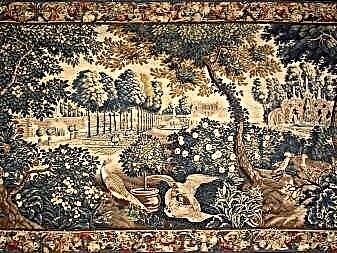

Each nation had its own name for trellis: among the Greeks - “tapes”, in Italy - “Arezzi”, in Latin - “tapetum”. The word tapestry itself comes from France. In the XVII century, the Royal Tapestry manufactory was opened, giving the name of its products.
Moreover, experts say that only products of this factory can rightfully be called "tapestries", while the rest are trellises.
It is worth noting that the scope of woven art is large and diverse. In addition to utilitarian and decorative properties, trellis is still used as upholstery for upholstered furniture, as elements of clothing or clothing in general (to create traditional outfits), as a replacement for classical icon painting, in the heraldic sense, and so on.

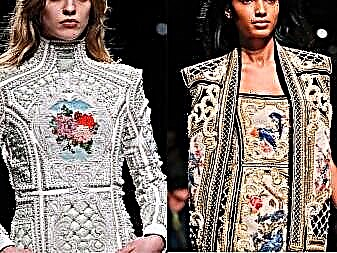
Manufacturing technique
Traditionally, tapestries are handmade. The process resembles weaving lint-free carpets, but it is more time-consuming and painstaking, since the threads are much thinner and the drawing is very detailed.

Initially, the main tool for creating the product was an ordinary frame, on which the warp threads were pulled. To achieve the desired tension, nails were used, driven into the frame or evenly made special holes on the inside of the frame itself. The weft thread wound on a spool or simply wound into a ball is thrown between the warp threads, and after the row is completed, it is beaten with your fingers or with the help of a special mallet.
A process using a machine is considered more technical. Its feature is that the machine can be placed both horizontally and vertically.


The master works according to the sketch drawn on cardboard, and the size of the picture and color completely coincides with the dimensions and colors of the future trellis. But despite the fact that the weaver has to copy another work, he must have artistic inclinations, be able to preserve color reproduction, understand the intricacies of the image of chiaroscuro, imagine what the finished woven work will look like in order to choose the right thread in this row.
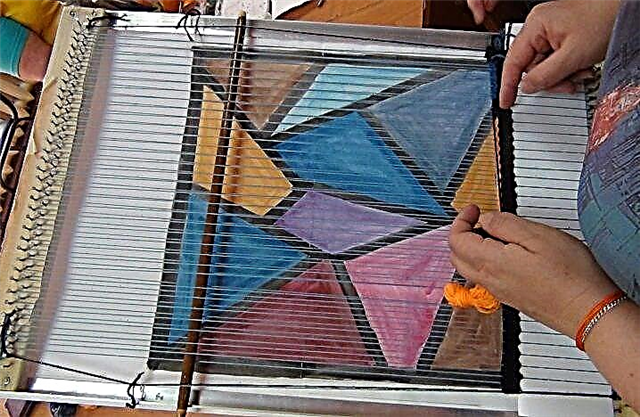
Large factories that produce products on a global scale even organized art schools at their factories, which increased the quality of the finished product.
Since the process of creating this canvas is very laborious and time consuming, up to 5-6 people can work on one trellis. Thus, one work is divided into several parts, which are then sewn with silk thread. One could understand this by looking at the wrong side: there were seams on it.

Due to the large number of techniques it is possible to achieve a variety of effects in the manufacture of trellis. If in the classical form the warp threads remain invisible, then in the modern design, masters can deliberately leave them on the front side of the picture. This technique is called rep, because the fabric takes a certain relief in the hem, which in translation into French sounds like “rep.”


The modern tapestry as an element of decor has undergone great changes in recent decades. This type of decoration of walls and various surfaces has become so popular in recent years that it simply had to become more affordable among the masses.
A fully woven product is an expensive pleasure, few can afford such a sophistication. But the non-woven tapestry is very simple in execution, and outwardly almost indistinguishable from the original.
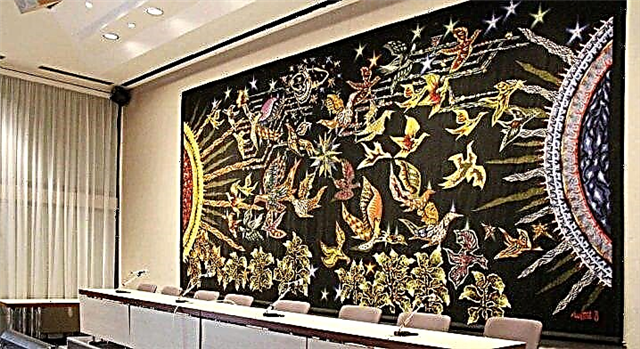
Such a product is created with the help of a special layout of the picture with colored fiber or threads on the basis. It is difficult to call a product a tapestry in the traditional sense of the word, because a “tapestry” is, first of all, a woven fabric. However, the laid out pattern has a woven texture and a very detailed and dynamic pattern.

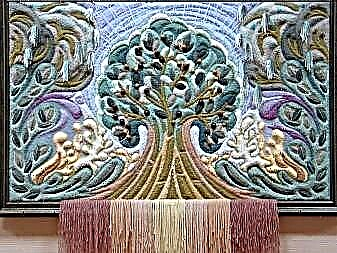
Chinese craftsmen came up with another type of non-woven trellis. Panels are made without using knitting needles or hooks. All elements are made of cardboard, on which yarn is subsequently wound. The master glues ready-made parts to a fully wrapped base and frame, creating a composition.

Advantages and disadvantages
The tapestry has many advantages as a decor element. This picture looks very elegant, you want to look at it, remember every element, it magically draws attention, creates coziness and a warm atmosphere in the house.
In a practical sense, such an acquisition will also be useful. The canvas has an antistatic property and does not attract dust, the fabric holds its shape well, does not warp and does not deform, and is easy to clean. Tapestries are suitable for any style in the interior, the main thing is to choose the right picture.


The disadvantages include a relatively large weight, which does not allow the use of equipment in relation to everyday clothes. At home, it is better not to wash and iron the product, as this may affect its appearance.

Main characteristics
Each nation had its own way of weaving tapestries. They differ in texture and material used. Currently, to create a specific relief, the master selects any necessary manufacturing method.

- Linen weaving is considered the most common and has wider application among craftsmen. To create a product, the weft thread in a checkerboard pattern passes through the warp threads. Thus, the first prokidka overlaps even warp threads, and the second - odd.
- Egyptian weaving creates from the weft of a duck a kind of ordinary pigtail. This effect is due to the fact that the thread that creates the pattern is braided around the warp thread by a knot and tightened. This process is one of the most labor intensive. Often, only certain elements are woven in this way.
- Greek weaving does not form a dense, loose surface. To knit a row, 2 or 3 weft threads are required, which are intertwined with each other with warp threads like an ordinary braid.

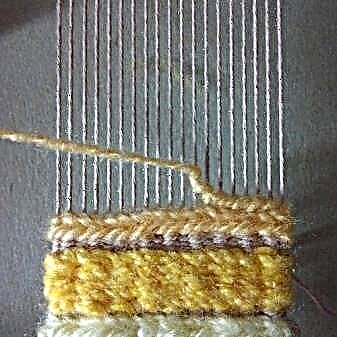
More complicated methods of weaving: knitting, sumac weaving, twill, giordes, hay. Each differs in density, relief, and the possibility of manufacturing elements of varying complexity. Each method has its own material.
Woolen, cotton, silk threads can either emphasize the relief, or vice versa, to create a perfectly smooth surface.

Trendy patterns and colors.
Since these products have a centuries-old history and are considered an attribute of antiquity, in our time it is considered fashionable to emphasize precisely this property. Proceeding from this, the theme of the tapestry drawing reflects moments not related to modern life - these are illustrations for a medieval book or a woven reproduction of a work of the Renaissance, an image of a hunting scene in Russia.
Such canvases, even made in modern factories, will make you think that perhaps this particular tapestry once hung in the palace of the king of France. The interior will immediately acquire a “history".
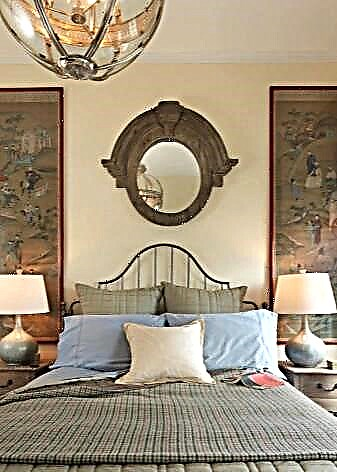

Another "classic" performed by tapestries is the image of nature on canvases. Tapestries with deer, bears, horses and simply gorgeous landscapes are a more democratic option than, for example, classic battle scenes.
For romantic persons who prefer styles such as shabby chic, flowers on tapestries perfectly complement the interior design. Chic peonies, roses, hibiscus - the main attributes of the antique style. More infantile plots are shots from anime films or images of cute cats and puppies on canvases. Woven calendars are an original way to find out the date and emphasize the stylistic orientation of the interior.

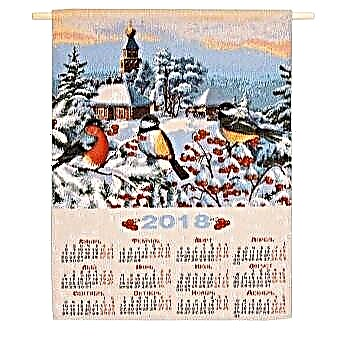
In the historical sense, tapestries do not have too bright colors. Previously, there were no pigments capable of creating, for example, a juicy lime or sky blue color, all shades are muffled, soft, but deep. Based on this, choose a tapestry for classic and minimalist interiors in these colors. You can experiment with colorful pop art designs with paints. For the plot, there is certainly food for thought.


Areas of use
In the modern world, the use of tapestries has somewhat narrowed. Because of its severity, tapestries are not suitable for the full-fledged production of clothing, although in ancient times woven robes and dresses were considered traditional clothing in Japan and China. Designers in the world of haute couture continue to create haute couture outfits using this technique, but it is unlikely that such models will reach the ready-to-wear collections.
But the elements - the processing of the edge of the sleeve or lapel on the jacket, can be found in everyday life.
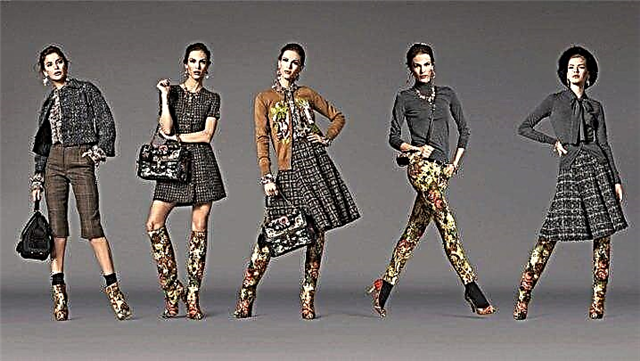
In interiors, their scope is wider. From jacquard fabric sew upholstery for furniture, pillowcases, bedspreads.If we talk about the ancient uses of trellis, it is enough to recall Homer's Odyssey, in which Penelope wove shrouds for her father-in-law, since housing construction technologies were low and woolen carpets were woven for shelter from drafts and cold. For kings during travels and military campaigns, whole tents made of tapestries were prepared.


Top manufacturers
There are many weaving factories specializing in the production of tapestries or having one of the areas associated with them, both in Russia and around the world.
The city of Ivanovo is famous for the manufacture of a variety of fabrics. Ivanovo tapestries are used for the manufacture of pillowcases, paintings, panels, curtains, bedspreads, napkins, bags, calendars. Designers, artists, design specialists and workers responsible for the smooth operation of the machines work in the factories. All the equipment was mainly manufactured abroad, and the experience in creating drawings was transferred from the masters from China, Turkey and Italy.
You can buy Ivanovo tapestries at exhibitions of Ivanovo products, at retail points of sale, as well as through online stores.


Since the end of the fifteenth century, Flanders took the championship three centuries ahead in the workshop production of trellis of the highest class. The main centers were the cities of Belgium - Bruges and Antwerp, and a little earlier Arras. The main difference of the Belgian tapestries is the introduction of “Cypriot gold” threads into the fabric - twisted silk or linen was entwined with gold or silver wire. Precious metals are included in the product, which gives a special price to the canvas.
To date, Belgian tapestries are unique and are considered an expensive acquisition.
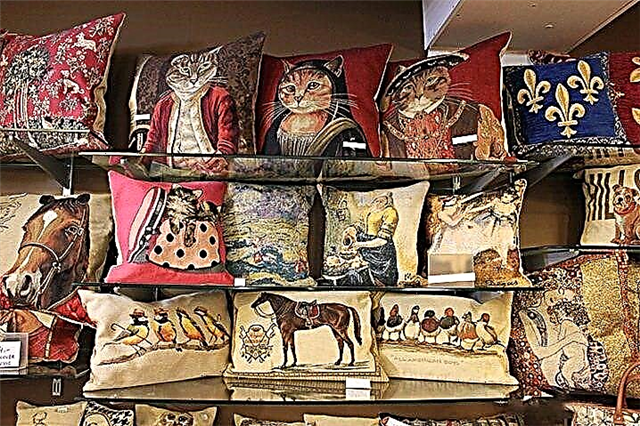
Along with them, French and Italian products incorporate the traditional aspects of weaving, compatible with the latest technology. European factories offer panels with medieval motifs, and are also ready to create reproductions of contemporary artists.
France, Belgium and Italy from ancient times to this day are considered classic manufacturers of tapestries.


For unique and colorful solutions, it is recommended to turn your attention to the East. Here, handicrafts are represented by Indian, Chinese and Japanese craftsmen. Subject tapestries from India - traditional ornaments, images of elephants, the god Shivva and other deities.
Chinese tapestries also reflect elements of history and tradition. Many motifs are devoted to the depiction of nature, amazing and beautiful colors, significant events.
Japanese products are striking in their colorfulness. A common theme is Japanese women in national costumes with all kinds of cultural attributes, branches of blooming sakura, landscapes, and architectural elements.

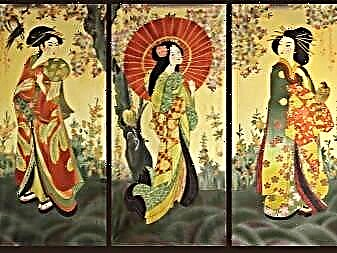
Interior Application
When it comes to tapestries, the first thing we present is a beautiful woven fabric on the wall. This picture can be hung in an ordinary apartment, but in a large country house it will look much more harmonious. Moreover, manufacturers not one century ago came up with ensembles of 3, 5 or 6 tapestries, united by one theme. Such a solution allows you to place a whole story on the walls: about knightly deeds, about great but unhappy love, about campaigns and great conquests.
This makes it possible to fill the room with meaning, to add depth to the design idea.


The size of the wall trellis depends on the size of the wall and interior design. The large tapestry throughout the wall looks powerful and luxurious. In this case, the decoration of the wall itself should be modest, monophonic, so that a chic canvas captures all the attention.

Monochrome tapestries decorated with metal threads can fit into high-tech interiors, although they are not considered a traditional element of this style. Miniatures in wooden frames will fit into a small room. This is a great choice for creating comfort in the bedroom. Sketches in the Provence style will complement the interior of the kitchen, if they are correctly combined with the drapery of chairs, curtains or pillows.


Tapestries are simply made for styles such as Baroque and Rococo. Historically, trellis has been widely used at the height of these styles. Beautiful paintings depicting nature, flowers, androgynous celestial beings, angelic phenomena, love scenes will complement the luxury of architectural forms.

Woolen carpets on the floor, made in tapestry technique, combine lint-free and pile elements. Their basis is mainly smooth, but the pattern is made in the form of flowers and curls of soft pile. This design has antistatic properties, attracts less dust, and the product is light and thin.
In addition, jacquard fabric is often used for upholstery. Solid wood furniture draped in tapestry with floral motifs is considered ideal. Special lovers of woven products can treat themselves to the New Year and buy a tapestry in the form of a calendar.
Care Tips
A tapestry is first and foremost a fabric, and this should be the starting point for caring for the product. Due to the fact that natural threads are used in the manufacture of the product, the washing machine is strictly contraindicated for them. But it is better not to wash the trellis manually. This can lead to deformation of the material, the product can “get hooked” or vice versa, stretch.
At home, it is best to use dry cleaning with a brush and a vacuum cleaner. For stubborn stains, use a dry cleaning service.


An old antique canvas is best given for restoration. There are not very many masters involved in the restoration of tapestries, but a product requiring such careful attention does not require neglect. Restorers know the peculiarities of working with such a fragile thing and will not let it go bad and lose value.
For more information on using tapestry in a modern interior, see the next video.
Rooms and drawings
- Mythical creatures. You need to be careful with them, because they seriously occupy the imagination and indirectly affect the psyche. Such drawings can be hung anywhere, but not in the resting place - the bedroom.
- Architectural buildings and heraldry. Suitable for any room, but they will look good only in rooms with rather high ceilings and additions like oak furniture, massive doors, antiques.
- Reproductions of famous painters. They look good in the living room, where you can leave your thoughts for a long time and travel inside for long evenings by the fireplace, living historical events.

Art lovers can find woven paintings by famous artists - in certain interiors it will look quite original
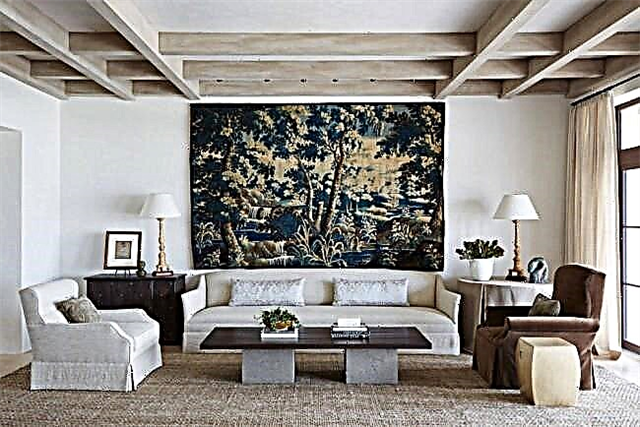
It looks especially good on a white painted wall and may well replace the wall painting or mural
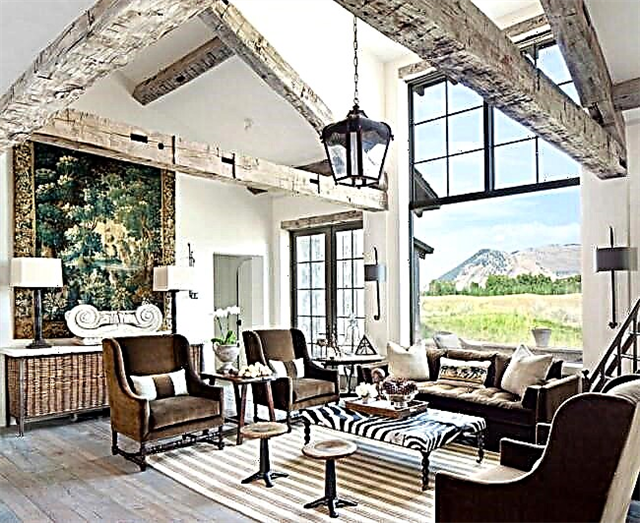
Consider the size of the wall when buying trellis - the big picture will look good in the open free space and will make it more comfortable

A good decoration idea would be to hang such works of art on either side of the fireplace
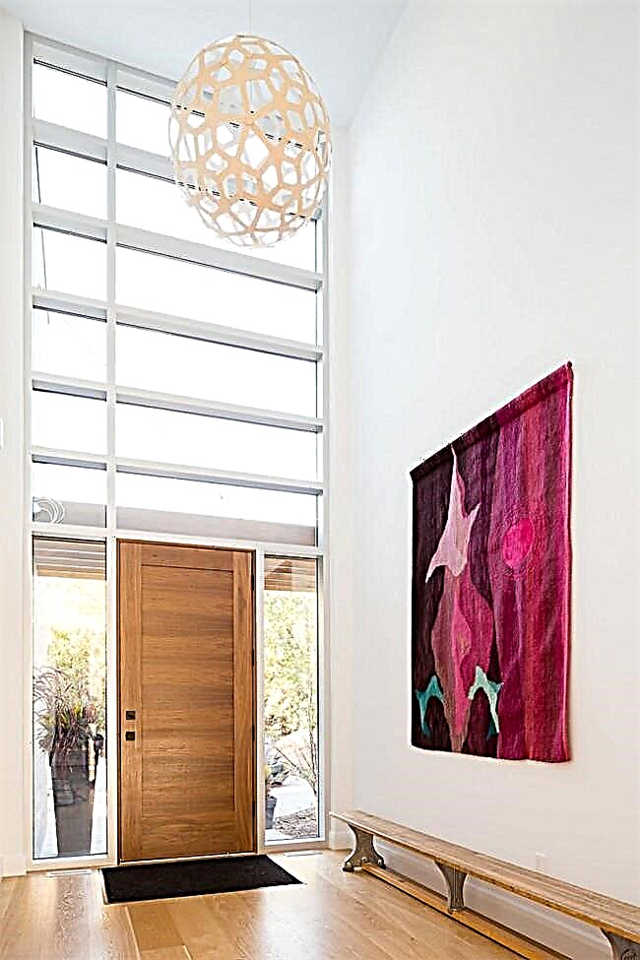
Spectacular corridor wall decoration

Tapestry above the bed - bright note in the bedroom of the house-chalet
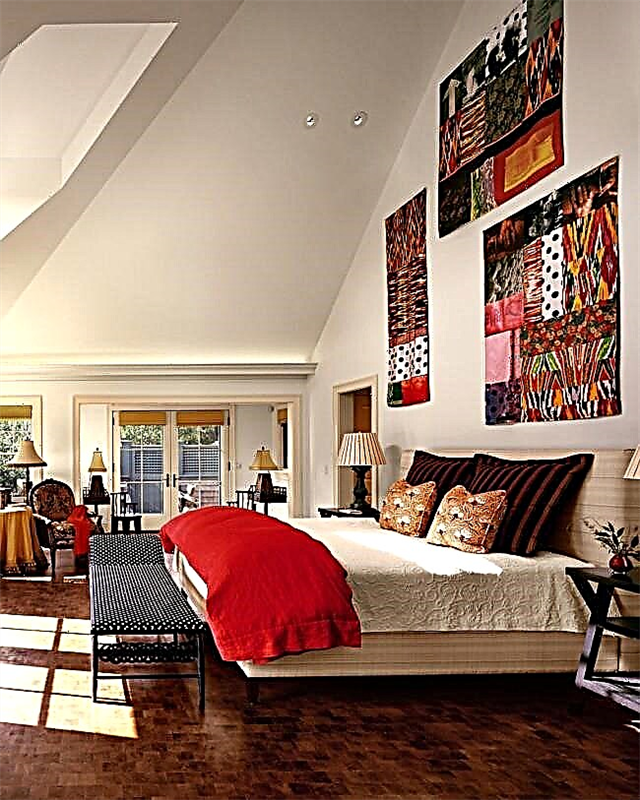
Screaming tapestries on the walls, echoing with bright accents in the room, look very stylish and harmonious.
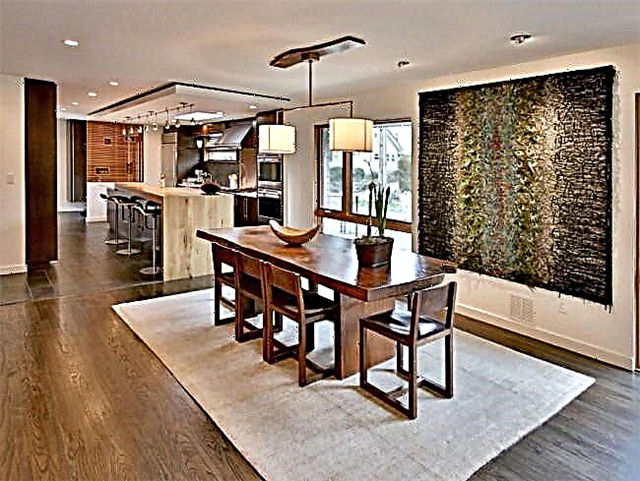
Tapestries can be with a modern pattern, for example, with abstract motifs.
This year's tapestry products in no way can be considered an echo from the past, the designers endowed them with original moments and color. The tapestry today is a unique bridge that skillfully combines masterpieces of masters of past centuries and modernity.

